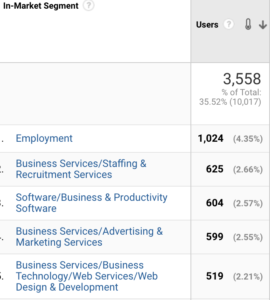Why Audience Personas?
If you ask a business “who should you be prospecting?” they often think they have an idea of who their audience is based on hunches and assumptions.
Attacking hunches with ads can often lead to overspending and under-delivering so, at Bind, we love to dive deep into the data to make sure that we are approaching the right people, at the right stages of their purchase journey and with the right offer and creative.
Audience personas have long been the go to way to visualise the buyers you are trying to reach out as a business. It’s hard to argue against the fact that, if you can speak directly to your audience, that your marketing efforts will be more successful.
More and more every year we gain a better understanding of user behaviour and search and social media giants give us better audience insights and so, in our opinion it makes sense to harness this data to help build better foundations for buyer personas.
It’s also fruitful to frame your marketing using audience personas to ensure you are always thinking about the customer’s perspective. It helps you to cease rehashing the same USPs and industry jargon that your audience, frankly, doesn’t care about as much as you do.
If your audience has an affinity with your messaging, creative and purchase journey, this will improve your click-thru and conversion rates. Furthermore, it will also enable you to cut through broader audiences and train the ad delivery algorithm to optimise towards the right type of people.
Whilst this is a definite advantage, it also means that you need to back up your persona creation with reliable insights to make sure you are barking up the right tree(s).
Traditionally, buyer personas are dreamt up in stuffy boardrooms or focus groups, and there is definitely merit to that. These traditional methods are great, but when harnessing the power of first-party data, you can hone in your approach with higher certainty and confirm your biases.
If you still aren’t quite sure what a buyer persona is here is an example:

Audience Persona Example
Name: Sophie
Age: 28
Education: University Graduate
Work: Audience Insights Analyst
Goals: To succeed at her job and start to climb her career ladder, find a tool to help her measure her audience insights
Frustrations: Most of the tools she sees don’t really explain what they do in a straight forward manner.
Loves: Coffee Shops, Fairtrade Chocolate, Corporate Responsibility, Veganism
Hobbies: Live Music, Photography, Socialising with friends, Cooking
Traits: Compassionate, Cares about the world, dislikes corporate jargon, loves creativity.
Of course, Sophie is fictional and your audience personas are never based on a real person, rather a stereotype of sorts that represents a subsection of your audience. What a buyer persona does do is gives you someone to appeal to. What does this customer’s persona tell you about how you should market to them as an individual?
Who your customers are should be thought about in every element of your digital activity from your channel selection, media buying, copy, creative and landing page experience. So how do we use audience insights to do it?

But What About B2B?
I hear you, “I market B2B, why should I care?” And the answer is, decision-makers are people too! Humans are social creatures that crave interaction and, even at work, purchase based on an emotional connection to your brand.
It’s true that in B2B there is a lot more logic involved in purchase decisions, but it’s often relating to the brand that pushes them over the line, although they would probably never tell you or their colleagues that and that’s if they even realise it.
Whilst you may have a list of companies that are your ideal clients, the decision-makers are the ones you have to win over and push to make contact with.
In B2B, if you are one of the few that don’t avoid or ignore the human approach to marketing, you are already at a massive advantage. This means that getting it right will make your business cut through the B2B echo chamber of corporate jargon effortlessly and give you the upper hand when reaching those all-important decision-makers.
Importance of Data Hygiene
Data Hygiene should be an essential part of any paid media strategy. When feeding intricate platforms such as Facebook and Google, data hygiene can make or break the success of campaigns.
This includes conversion signals being tracked adequately but also the cleanliness of your customer lists.
One aspect that is often overlooked is your internal traffic. Every company has a wide variety of people working for them and, whether they are a large company or not, an overwhelming majority of their employees likely don’t fit within their target audience.
For this reason, it is crucial to ensure that these people are not being served ads, don’t end up in your customer lists and are not included in your audience insights.
If you have excluded based on IP addresses, then, due to recent events, these people may no longer be excluded. A larger proportion of people are working at home than they ever were before.
I recommend checking out Josh’s blog post on “Filtering out ‘working from home traffic’ in Google Analytics” if you are struggling with this issue.
The cleanliness of your customer lists is important to ensure you are filtering out bad contact details whether that is incomplete, general spam, disqualified leads or anything else that you deem insignificant data in your vertical.
It’s also worth noting that these lists should only be segmented as far as there is a significant enough data pool to train algorithms or provide you meaningful insights on different types of customers.
It is a bad habit a lot of marketers have to try and narrow their approach to different personas too much this almost always leads to under-delivering. This is especially true with Facebook, where overly narrow audiences don’t deliver at all.
Confirming Demographic Trends
Primarily, we use audience insight tools to decide what the existing audience already looks like. The aim is to help us gain a better understanding of the audiences that already engage and follow your pages to confirm demographic trends.
We would recommend having all of the below tools in your wheelhouse. The more data points you have the clearer of a picture you will be able to paint of your audience.
Facebook Audience Insights
Historically, a really powerful way to do this was by plugging in your custom audiences into the Facebook Audience Insight tool. From there, you could see what other pages they had an affinity with, trends in interests, age and marital status, which allowed you to analyse your data directly.
Due to privacy concerns restrictions on these sorts of tools from Facebook have been coming in waves since the infamous Cambridge Analytica scandal.
However, it only takes a little bit of research directly with your customers to build up these sorts of images. Later on, we’ll discuss the importance of gaining qualitative and quantitative data from your audience; from there, you may be able to create what your audience looks like within this tool manually.
Another method, If you have a large enough following on Facebook, is you could plug in your page followers into the Audience Insights tool and gather demographic trends and affinities.
This is a viable option if you are using Facebook as a primary channel. Still, otherwise, you may find yourself unable to have a large enough audience size for this to show actionable insights.
LinkedIn Website Demographics


LinkedIn’s option in this space can tell you more about the professional life of the people that visit your site. Using their insight tag, it matches your visitors with people on the platform and allows you to pivot them based on the attributes to the left
This is useful for both B2B and B2C marketers to gain an idea of the sort of careers, companies, seniority that their typical website visitor has.
You can create audiences based on URL destinations and goal completions and gain an idea of how their professional life correlates.
Top Tip: If you are using LinkedIn for paid advertising, then you can also see how people are responding to your ads based on these attributes as well, which can help you make targeting decisions better.
Google Analytics


Using your universal analytics tag, Google can match your site visitors with the data they hold and provide you with in-market and affinity audience as well as age, gender, location, browser and device information. This can give you a great idea of the sort of people that are engaging with your site.
As well as this, Google Ads allows you to get under the hood of your converters within the Audience Insights section of Audience Manager. Within here, you can gain visibility on demographic, affinity and in-market data.
How can I really narrow this down?
Insight tools are great because they can provide you with top-quality demographic information but where they lack is often in their interpretation of interests and psychographic data. For this reason, We would recommend diving into quantitative and qualitative research.
We would like to preface this by saying that you should only gather relevant information and ensure that the process is anonymised.
Suppose you have a sales team or people working in customer-facing roles within your company. In that case, a focus group with employees is a great place to gather qualitative data on what your customers are really like.
Ask them to describe a few different typical customers using the parameters you set out. Useful parameters could be Job roles, industries, pain points, what they like about the company, interests etc.
Surveying customers is another sure way to get the information straight from the horse’s mouth. A good mixture of qualitative and quantitative data capturing is essential here, make sure to give the customers a chance to say things in their own words as well as ticking boxes. This will enable you to analyse personality traits that your customers may have with a higher degree of certainty. Note the type of language they use in this setting, their general sentiment towards the company and their values.
Analysing and quantifying these personality traits can be a very laborious job if you aren’t a data scientist. However, it is definitely worth the time if you don’t have the budget for tools that can automate this process.
Whilst you can send this out in an email campaign, this involves users making a special effort to complete it. Another recommended way of doing this is using a tool like Usability Hub or Hotjar to add in a survey. You can set these to appear on certain pages so a fair use case would be within a gated user area or after checkout confirmation. This ensures you aren’t disrupting your user sign up or cold traffic user experience whilst also giving you a much higher likelihood of getting quality survey fill outs.
What If I Don’t Have Enough Data Yet?
If you have a limited number of customers at the moment, we recommend setting yourselves up in a way to capture all of the information you can. Ensure that you are set up with necessary tracking tools (Google, Facebook, LinkedIn, HotJar) so that you are gathering this information from the word go.
The time will come that you have a large enough sample size to affirm your audience personas but until then make sure that you are capturing all the audience insights information that you can.
Now What?
Now that you have conducted all this research, you mustn’t let it get lost. Make sure that it is communicated to everybody that has an impact on your marketing so that they can use this to inform their new approach. Now is a perfect time to optimise your website and refine your strategy and messaging across all channels to reflect your new, concrete audience personas.
Test the data against your targeting, build lookalike audiences based on your segmented customer lists and analyse.
At this point, ensure that you measure how this affects your results. Audience personas are an ever-evolving piece of work that can be adjusted to ensure that you get that uplift you desire.
You’ll find that any sales and customer-facing departments would be delighted to have reliable buyer persona examples backed up by audience insights too, so go forth and win yourselves a favour with them as well!
If you would like to chat to myself or the team at Bind about how best to inform your audience personas with data, please reach out, we’d love to chat with you.




